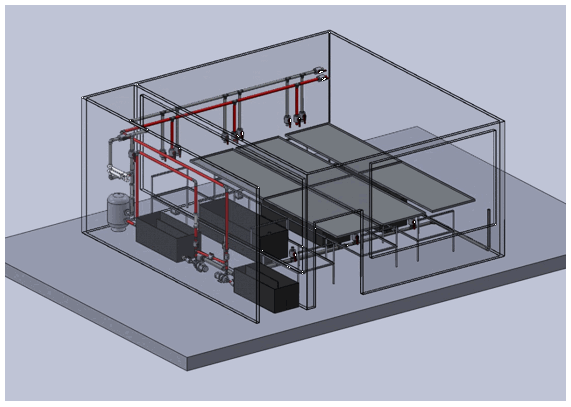AQUAPONICS AND THE PROSPECTS OF LARGE SCALE COMMERCIAL PRODUCTION
Introduction
The essential elements of an aquaponic system consists of a fish rearing tank, a settleable and suspended solids removal component, a bio-filter, a hydroponic component and a sump. The biofiltration and hydroponic components are normally combined in aquaponic production systems by using a plant support media, such as gravel, which also functions as a biofilter media. Raft hydroponics, which consists of floating sheets of polystyrene and net pots for plant support, can also provide sufficient bio-filtration if the plant production area is sufficiently large (Rakocy, J.E., 2012). However, neither of those technologies is particularly attractive for large scale commercial producers of aqua- or horticultural produce. For aquaponics to expand within these industrial sectors, a semi-commercial and research oriented aquaponic test plant has been designed and built in Denmark to both accommodate well-known industrial based aqua- and horticultural technologies as well as addressing important challenges within aquaponics.
Materials and methods
The test plant is set up in an existing greenhouse research facility. Six plant tables arranged in pairs are covering the three rectangular fish tanks with a usable volume of 2 m3 each. Plant tables will produce products in pots with soil, and open up for later organic certification of the aquaponic system. The oxygen supply to the fish tanks will be secured by three independent air blowers. The tanks are connected to a central water discharge line that ends in two sedimentation chambers. These chambers do not only serve as pre-filtration system but also as pump sumps. Each chamber is connected to one separate lift pump providing a pumping capacity of around 15m3/h. The total water flow is split into two basically independent loops. In one of them, the fish loop, the pumps is supplying water to a bead-filter that acts as a mechanical- as well as a biological filter and one in-line ultraviolet disinfection system (uv system) connected in series. From the uv system the water can be lead to the plant tables and/ or directly back to the fish tanks located beneath the plant tables. The water from the plant tables can also enter the fish tanks by gravity or can directly be discharged into the main discharge line and the sedimentation chambers. In the second loop (plant loop) the lift pump supplies the water directly back to the plant tables from where it will enter the fish tanks. Both lift pumps are frequency regulated, furthermore the plant loop pump is equipped with a timer that allows to pre-set pumping time and -duration to follow a "flood & drain" watering schedule of the plant tables. The oxygen supply to the fish tanks will be secured by three independent blowers
Introducing two separate loops, one for plants and one for fish, gives a very high degree of flexibility and safety of production. The system allows the gradual reduction of the independence of the loops up to a system solely depending on the mutual symbiotic relationship of plant- and fish production. If at any time there is an imbalance of the two components it is possible to (partly) separate the processes and stabilize the system again.
Results
Expected results are: 1) developing aquaponics as a flexible module system that can be applied to a broader spectrum of existing commercial and specialized large scale aqua- or a horticulture producers, 2) reducing the fixed costs substantially by utilizing 'economies of space' when integrating two production systems into one aquaponics, 3) reducing production risks and mutual dependency by introducing separate production loops 4) raising labor productivity substantially within aquaponics so larger scale commercial investments become more attractive, 5) introducing soil in the plant production opening up for organic certification of aquaponics in the EU
Discussion and conclusion
The test plant integrates already well-known technologies and production systems applied in large scale modern aqua- and horticulture production systems, and hence designed to eliminate a pre-barrier of insecurity when introducing aquaponics as a commercial option in the two industrial sectors. The test plant has also been designed to minimize the mutual dependency risk in aquaponics by introducing separate (but integrated) nutrient loops in the event of problems or failures in either the aqua- or horticulture section to avoid a complete shut-down of the whole aquaponic system. Likewise, to reduce the higher fixed costs in aquaponics the test plant has applied 'economies of space' (fish tanks underneath the mobile plant tables), and together with the symbiotic effects with savings on variable costs on nutrients, water and CO2 paving the way for a commercial viable balance sheet when aquaponics go large scale.
References
Rakocy, J.E. (2012): Aquaponics - Integrating Fish and Plant Culture, in Aquaculture Production Systems (ed.) James H. Tidwell, Wiley-Blackwell, USA
